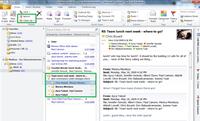Jefferson Graham and Byron Acohido
USA Today

A Google worker rides a bike by a sign at the company’s Mountain View, Calif., offices in 2007. By Justin Sullivan, Getty Images file
Challenging Microsoft‘s grip on PCs, Internet search giant Google said late Tuesday night that it intends create its own computer operating system.
Google said the OS is initially aimed at netbooks — small, cheap and incredibly popular sub-notebooks — and would be an “open source” project built with and by many developers.
Google is currently meeting with hardware manufacturers to aprise them of its plans, and hopes to have it on computers by the second half of 2010.
Google has denied for years any interest in taking on Microsoft, or Apple with its own operating system, but Tuesday took a new direction.
In a blog post on the official Google blog, Google positioned the new Chrome Operating System as the “natural extension” of Chrome, the Internet browser Google introduced to acclaim in 2008 and which now has 30 million users.
The new operating system is “our attempt to re-think what operating systems should be,” wrote Google’s Sundar Pichai, vice president of Product Management.
Google Chrome OS will focus on “speed, simplicity and security,” he said, similar characteristics to the Chrome browser, which advertises itself as ultra-speedy.
Both Microsoft and Apple have plans to release new operating systems in 2009. For Microsoft, Windows 7 is an opportunity to erase the stain left by poor customer response to Vista.
Just because Google wants to get into operating systems doesn’t automatically mean it will be a success, says SearchEngineLand editor Danny Sullivan. “But if I were Microsoft, I’d be nervous.”
In the blog post, Pichai outlined Google’s goals: “We hear a lot from our users and their message is clear — computers need to get better. People want to get to their email instantly, without wasting time waiting for their computers to boot and browsers to start up. They want their computers to always run as fast as when they first bought them. They want their data to be accessible to them wherever they are and not have to worry about losing their computer or forgetting to back up files. Even more importantly, they don’t want to spend hours configuring their computers to work with every new piece of hardware, or have to worry about constant software updates. And any time our users have a better computing experience, Google benefits as well by having happier users who are more likely to spend time on the Internet.”
Google has been trying to fly somewhat under the radar with its plans to get into the PC operating systems business. Since launching its Linux-based Android operating system for mobile handsets, it has been quietly talking to all major computer makers about extending it into netbooks, says Rob Enderle, principal analyst at Enderle Group.
“Every major OEM (original equipment manufacture) I know has some sort of Android netbook project in the works,” says Enderle.
Enderle said he could not disclose specific names of PC makers who are planning to deliver netbooks using the operating systeem. And he said Google is not expected to have it ready for most of the major netbooks manufacturers until 2010.
But upstart PC maker Acer jumped the gun by recently announcing plans to bring Android-powered netbooks to market by late this year. Presumably, they will be lower priced than Acer Windows or Acer Linux netbooks, since Google is expected to supply the operating system for free, or a nominal fee, to PC makers, says Enderle.
“Google is left to execute, but the potential to be disruptive is very high,” says Enderle. “This may be the biggest threat Microsoft has ever faced to one it its keystone products.”
The scenario Google is hoping for is that netbooks using its operating system become a major offering from all netbook manufacturers in early 2010. That would give the search giant a small toehold on the operating landscape.
Introducing the Google Chrome OS
July 7, 2009
It’s been an exciting nine months since we launched the Google Chrome browser. Already, over 30 million people use it regularly. We designed Google Chrome for people who live on the web — searching for information, checking email, catching up on the news, shopping or just staying in touch with friends. However, the operating systems that browsers run on were designed in an era where there was no web. So today, we’re announcing a new project that’s a natural extension of Google Chrome — the Google Chrome Operating System. It’s our attempt to re-think what operating systems should be.
Google Chrome OS is an open source, lightweight operating system that will initially be targeted at netbooks. Later this year we will open-source its code, and netbooks running Google Chrome OS will be available for consumers in the second half of 2010. Because we’re already talking to partners about the project, and we’ll soon be working with the open source community, we wanted to share our vision now so everyone understands what we are trying to achieve.
Speed, simplicity and security are the key aspects of Google Chrome OS. We’re designing the OS to be fast and lightweight, to start up and get you onto the web in a few seconds. The user interface is minimal to stay out of your way, and most of the user experience takes place on the web. And as we did for the Google Chrome browser, we are going back to the basics and completely redesigning the underlying security architecture of the OS so that users don’t have to deal with viruses, malware and security updates. It should just work.
Google Chrome OS will run on both x86 as well as ARM chips and we are working with multiple OEMs to bring a number of netbooks to market next year. The software architecture is simple — Google Chrome running within a new windowing system on top of a Linux kernel. For application developers, the web is the platform. All web-based applications will automatically work and new applications can be written using your favorite web technologies. And of course, these apps will run not only on Google Chrome OS, but on any standards-based browser on Windows, Mac and Linux thereby giving developers the largest user base of any platform.
Google Chrome OS is a new project, separate from Android. Android was designed from the beginning to work across a variety of devices from phones to set-top boxes to netbooks. Google Chrome OS is being created for people who spend most of their time on the web, and is being designed to power computers ranging from small netbooks to full-size desktop systems. While there are areas where Google Chrome OS and Android overlap, we believe choice will drive innovation for the benefit of everyone, including Google.
We hear a lot from our users and their message is clear — computers need to get better. People want to get to their email instantly, without wasting time waiting for their computers to boot and browsers to start up. They want their computers to always run as fast as when they first bought them. They want their data to be accessible to them wherever they are and not have to worry about losing their computer or forgetting to back up files. Even more importantly, they don’t want to spend hours configuring their computers to work with every new piece of hardware, or have to worry about constant software updates. And any time our users have a better computing experience, Google benefits as well by having happier users who are more likely to spend time on the Internet.
We have a lot of work to do, and we’re definitely going to need a lot of help from the open source community to accomplish this vision. We’re excited for what’s to come and we hope you are too. Stay tuned for more updates in the fall and have a great summer.
Posted by Sundar Pichai, VP Product Management and Linus Upson, Engineering Director








